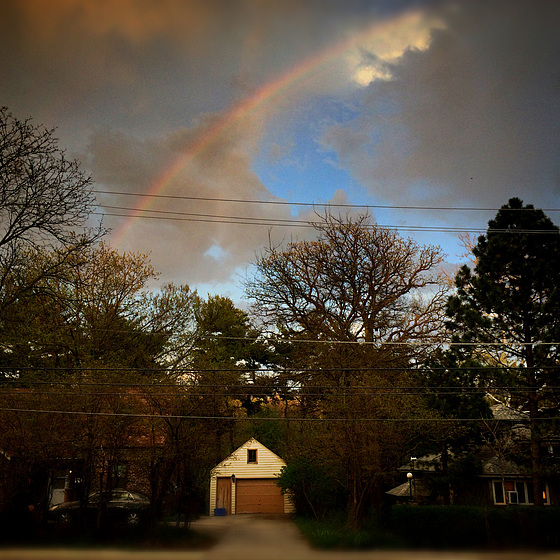In this day and age of technology you’ll never miss a picture of a rainbow.
Digital cameras changed photography, and now smart phones are changing digital cameras.
Yet, not too long ago my camera of choice was a Pentax and not an iPhone. But now the iPhone camera is becoming competitive, if not superior, to the DSLR or especially the Point and Shoot camera. I tried using Android phone cameras, and in my tests there is much more attention going into the iPhone camera by Apple than by Samsung or equivalent.
I am amazed sometimes in post processing a picture made with the iPhone how you often just need a slight tweak of the brightness or the exposure, and how this saves time. Which brings me to the point of this post, how making pictures of rainbows now is not so much about the camera as it is the photographer.
How you compose an image and tell a story is more simple and quick than ever, and less and less do you have to play with adjustments or post processing. I feel that no longer do I have to carry my Pentax wherever I go as I have for the past three decades. More on this in a moment.
One of the things I don’t miss about the DSLR is every time they put out a new model you then have to upgrade your editing software to be compatible with it. I must confess, though, I learned photography back in the days of film (and a Nikon), before digital, when composing through the camera viewfinder and setting all the details mostly was done before the click of the shutter. Even today with my digital Pentax I turn off the preview screen on the back so I don’t depend on it as too many today do, as well as ‘fixing’ it in post processing.
Yes we used techniques in the darkroom when printing from film, and it was just basic tweaking compared to what you can do today with programs like Photoshop and GIMP. For you photography geeks, you may arguably understand when I say that I’ve reasoned with shooting JPEG images only, no more RAW.
Because, when you shoot in RAW it makes you slave to the camera manufacturers formats, or at least the Adobe Digital Negative format, even though my Pentax is over a decade old. This way with JPEG it will always be able to be used in the (foreseeable) future no matter your camera, and editing software will not become outdated.
There are many photographers including myself who arguably can produce quality imagery from a JPEG compared to using a RAW file if not better. So, for example, the past several years that I’ve been RAW free there has not been an issue with quality in how the photography has been used.
The one argument, though, for using my Pentax still is with focal length or lighting for the most part. To zoom with an iPhone or to use different lighting techniques still needs improvement. Also the size of the sensor in a DSLR has an advantage in certain applications, and I still enjoy the (colors from the) CCD sensor which is no longer used in present models.
But for making pictures of general subjects, the iPhone camera shines. These little devices are really computers, compact and lightweight like never before. You can pull it out of your pocket and have it ready to shoot in a quick moment. Tap the screen to focus and click the shutter. I often shoot these days in square format, so composing an image is a snap, as you don’t have to play with turning the device for composition sake.
The great photographer Ansel Adams was known for preferring the square, and would crop from that if need be. Ansel was also a master craftsman in the darkroom, and I bet if he were living today, though he might use digital, his pictures from a film negative would still be unnoticeable if you compared it to a picture made from a digital negative.
Yes, it is said that more pictures have been taken with the smartphone camera than all the pictures in the history of photography ... or something like that.
So start snapping and sharing, and enjoy life.
Frank J Casella
www.ipernity.com/user/frankjcasella




After reading more of your articles, I realized you have a long professional background.
When it comes to phone cameras in general, it really doesn't matter what trademark it is. I try to write a review on phone cameras soon, where I explain what features one should look for, if and when one considers to invest on a new phone camera.
I have now used mobile phone cameras almost for a decade, and at least gained a lot of experience on them.
For mobile editing I recommend Snapseed. It is free, based on famous Nik Collection, and what's best, it keeps EXIF when editing images.
Sign-in to write a comment.